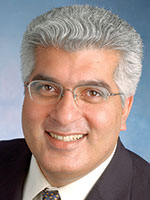Higher interest rates will significantly slow inflation and the overall U.S. economy during the remainder of 2023 and into 2024, before the Federal Reserve reverses course and cuts interest rates. Those are some of the key observations from the biannual economic conference hosted by the Economic Forecasting Center at Georgia State University in Atlanta.
“The last few hikes were to buy insurance against inflation resurgence,” said Rajeev Dhawan, director of the forecasting center. “Beginning in spring 2024 when the economy starts to bounce along the bottom, the Fed will come out with rate cuts, and people will be surprised by their aggressive pace.”
Dhawan said the rate of growth for the nation’s gross domestic product will slow from its expected 2.3% pace in the third quarter of 2023 to less than 0.5% in the first half of 2024, but once the interest rate cuts begin to take hold and credit is loosened and more money is available to invest in capital improvements, the economy will rebound to a more traditional 1.8% growth rate in 2025.
Also, Dhawan and his team believe the current period of significantly higher interest rates will have accomplished its goal of lowering inflation from more than 8% in the aftermath of the COVID-19 pandemic to 4.1% for 2023 and then 2.7% in 2024 and eventually to 2.4% in 2025, close to the Fed’s goal of an annual rate of 2%.

Dhawan
“Although the world has emerged from the downturn of the COVID pandemic, multiple factors are contributing to sputtering global economic growth,” Dhawan said. “China is not yet firing on all burners, which is holding down the rest of Asia. The Ukrainian-Russian conflict is casting a dark shadow over European growth. And Latin America economies are not performing well due to factors including bad debt, currency mismanagement and a lack of commodity demand from China.”
After about three years of sometimes spectacular month-to-month job growth, hiring in August slowed to 177,000, according to the Labor Department.
Dhawan is forecasting that job growth will turn mildly negative by the first half of 2024, with losses being reported for the first time since the beginning of the pandemic, but rebound to 75,000 in gains by mid-2025 as interest rate cuts spur investment spending. He’s expecting the economy to be adding 115,000 jobs per month by late 2025.
While American Trucking Associations Chief Economist Bob Costello and others say the trucking and logistics sector of the economy is in a freight recession, Dhawan says there’s another area of the economy in a recession, and that’s white-collar, middle-class, middle-management positions.

Transport Topics’ Seth Clevenger, Michael Freeze and Mike Senatore dissect the new Top 100 list of the largest private carriers, including how fleets are adapting to this softened market. Tune in above or by going to RoadSigns.ttnews.com.
Dhawan says corporations began thinning middle-management ranks during the pandemic, but they have changed their business model as more workers adapted to a hybrid work environment, spending two or three days at home per week.
“Businesses realized technology made it possible to run operations remotely without a large number of supervisors and reduced their ranks. Those jobs are not coming back,” he said.
But he said one group of employees is holding onto jobs, even as the economy slows.
“Frontline employees are a different matter. Whether a corporation or a restaurant, no business will let go of their frontline employees. Businesses learned their lesson after cutting frontline employees during COVID when they found out how hard it was to recall employees when consumer demand returned,” Dhawan said. “This difficulty filling frontline positions had never been the case during prior recessions, which has now created a situation of ‘labor holding.’”
Many officials in the trucking industry have said they are following that strategy and continuing to keep drivers and office employees and reduce — but not eliminate — recruiting, because it is too difficult to find quality employees, and those companies want to be ready for the uptick in the economy when it happens.
“This isn’t a recession in the traditional definition because job creation is continuing in the health care, hospitality and construction sectors,” Dhawan said. “But that’s not balanced growth. During the so-called Goldilocks economy of the late 1990s, two high-paying jobs were created for every one low-paying job. That is not the case now. High-paying job growth is completely stalled. The question is whether or not Federal Reserve rate cuts can spark a reversal.”
Dhawan’s remarks agree with those of Costello, who has said that the economy is in a post-COVID transition. At first in the recovery, purchases of goods dominated, and we are now returning to a more traditional balance of goods and services.
“But it’s not all doom and gloom,” Dhawan said. “Even in this sea of turmoil, there are islands of growth. Post-COVID, consumers are continuing to spend. They have shifted their firepower from purchasing goods to buying services. There is a lot of pent-up demand for domestic travel by car and by air, and that’s not going away anytime soon.”






